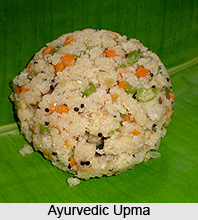 Ayurvedic Upma is one of the excellent ayurvedic dishes for doshic balance. It is a light diet in Indian cooking and is a staple breakfast in South India. Upma is quick to make and can be prepared at home. The basic ingredients required for preparing this delicious dish are creamed wheat or bear mush, black mustard seeds, cumin seeds, hing, curry leaves, turmeric, green chilli, onion, and coriander to name a few. Kapha can eat this in moderation if they increase the mustard seeds and chilli.
Ayurvedic Upma is one of the excellent ayurvedic dishes for doshic balance. It is a light diet in Indian cooking and is a staple breakfast in South India. Upma is quick to make and can be prepared at home. The basic ingredients required for preparing this delicious dish are creamed wheat or bear mush, black mustard seeds, cumin seeds, hing, curry leaves, turmeric, green chilli, onion, and coriander to name a few. Kapha can eat this in moderation if they increase the mustard seeds and chilli.
Ingredients Ayurvedic Upma
•Half cup of safflower oil or ghee
•One cup of creamed wheat or bear mush
•One teaspoonful of black mustard seeds
•One teaspoonful of cumin seeds
•A pinch of hing
•Five curry leaves
•Half teaspoon of turmeric
•One finely chopped green chilli
•One chopped onion
•One-fourth cup of coriander finely chopped
•Half teaspoon of salt
•Three cups of water
•Coconut and coriander leaves for garnishing
Method of Preparing Ayurvedic Upma
•Lightly roast the creamed wheat or bear mush wheat in a heavy, dry pan over medium heat till it is slightly brown. Stir or shake frequently. Keep it in a bowl separately.
•Heat a saucepan on medium flame and then add oil or ghee followed by mustard and cumin seeds.
•When the seeds pop add the other spices except for salt. Stir in the onion, chilli and coriander and cook till the onion turns brown in colour.
•Add the salt and water and boil it for some time. Stir in the roasted mush very slowly. Boil it for two minutes and stir continuously to prevent the formation of lumps. Now lower the flame and cover.
•Cook for another five minutes in case of creamed wheat and ten minutes for bear mush.
•Garnish with coconut and chopped coriander leaves when serving. Squeeze fresh lime in case of a tangy taste.
Ayurvedic Upma is nutritious and easy to digest. When consumed it soothes the stomach. It can be taken as lunch, dinner and even breakfast.




















